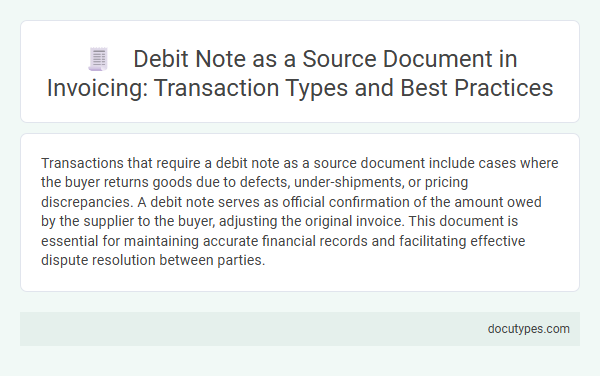Transactions that require a debit note as a source document include cases where the buyer returns goods due to defects, under-shipments, or pricing discrepancies. A debit note serves as official confirmation of the amount owed by the supplier to the buyer, adjusting the original invoice. This document is essential for maintaining accurate financial records and facilitating effective dispute resolution between parties.
Introduction to Debit Notes in Invoicing
| Introduction to Debit Notes in Invoicing | |
|---|---|
| Definition | A debit note is a source document issued by a buyer or seller to indicate an increase in the amount payable due to reasons like underbilling or additional services/products supplied. |
| Purpose | To formally request an adjustment to an invoice, reflecting a higher amount owed for specific transactions. |
| Transactions Requiring a Debit Note | |
| Underbilling Corrections | If an original invoice underestimated the amount payable, a debit note serves as the official document to rectify the billing. |
| Additional Goods or Services | Transactions involving extra items or services not included in the initial invoice need a debit note to increase the amount due. |
| Price Adjustments | Price increases after invoice issuance due to agreed terms or market changes require debit notes to document the additional charge. |
| Incorrect Invoice Details | If an invoice contains errors such as wrong quantities or rates leading to a lower billed amount, you must issue a debit note to correct the transaction. |
Definition and Purpose of Debit Notes
A debit note is a source document issued by a buyer to a seller, indicating a request for a credit adjustment on previously invoiced goods or services. It serves to officially notify the seller that the buyer intends to return items or adjust the billing amount due to discrepancies such as damaged goods or incorrect pricing. You require a debit note for transactions involving returns, price corrections, or billing disputes to ensure proper accounting and transaction records.
Key Features of a Debit Note as a Source Document
Certain transactions require a debit note as a source document to ensure accurate financial records and adjustments. You need a debit note when there is a need to increase the amount payable due to errors or additional charges.
- Correction of Underbilled Amounts - A debit note acts as proof when additional charges are raised after an invoice has been issued.
- Return of Goods - It serves as a source document when goods are returned but the seller has not yet issued a credit note.
- Adjustment of Account Balances - The debit note captures necessary modifications in the seller's accounts for transactions that increase receivables.
Common Transaction Types Requiring Debit Notes
Debit notes serve as essential source documents for transactions involving adjustments to previously issued invoices. Common transaction types requiring debit notes include underbillings, returned goods where prices were initially understated, and correction of errors in original invoice amounts. These documents ensure accurate financial records by formally documenting the increase in amounts owed by the buyer.
Debit Note vs. Credit Note: Understanding the Difference
Debit notes are required for transactions where the buyer needs to notify the seller about an increase in the amount payable due to reasons like returned goods or undercharged invoices. Credit notes, in contrast, are issued to document reductions in the amount owed by the buyer.
You use a debit note when adjusting the purchase value upwards, such as when additional goods are received after the original invoice. Credit notes serve the opposite purpose by confirming a decrease in the transaction value, often due to returned items or discounts. Understanding this distinction ensures accurate financial records and smooth transaction reconciliation.
Step-by-Step Process of Issuing a Debit Note
Certain transactions require a debit note as the source document to ensure accurate financial records. Understanding when and how to issue a debit note is essential for maintaining transparent accounting practices.
- Identify Transaction Type - Determine if the transaction involves returned goods, price adjustments, or undercharged invoices.
- Prepare Debit Note Details - Include essential information such as the original invoice number, date, amount, and reason for the debit note.
- Issue Debit Note to Customer - Send the debit note promptly to notify the customer of the additional charge and update your accounts receivable.
Following these steps helps you maintain accurate transaction records and ensures compliance with financial documentation requirements.
Essential Information to Include in a Debit Note
Transactions involving returns of goods or adjustments to previously issued invoices require a debit note as the source document. Debit notes serve as formal requests for additional payment from the buyer to the seller.
Essential information to include in a debit note comprises the debit note number, date, and reference to the original invoice. It must also clearly state the buyer and seller details, description of goods or services, quantity, price adjustments, and the total amount owed.
Legal and Accounting Implications of Debit Notes
Which transactions require a debit note as a source document? Debit notes are essential for transactions involving price adjustments, returned goods, or underbilled amounts. They serve as official records ensuring accurate financial reporting and legal compliance in accounting practices.
Best Practices for Managing Debit Notes in Business
Transactions involving returned goods, overcharged amounts, or pricing adjustments typically require a debit note as a source document. Businesses must issue debit notes to formally notify customers of increases in the amount payable.
Best practices for managing debit notes include maintaining clear documentation and integrating debit note processing within accounting software. Timely issuance and accurate recording of debit notes improve financial transparency and audit readiness.
Which Transactions Require a Debit Note as Source Document? Infographic

